 Ganador de categoría en los países:
Ganador de categoría en los países:
Fietsbrug Wielsbeke-Waregem
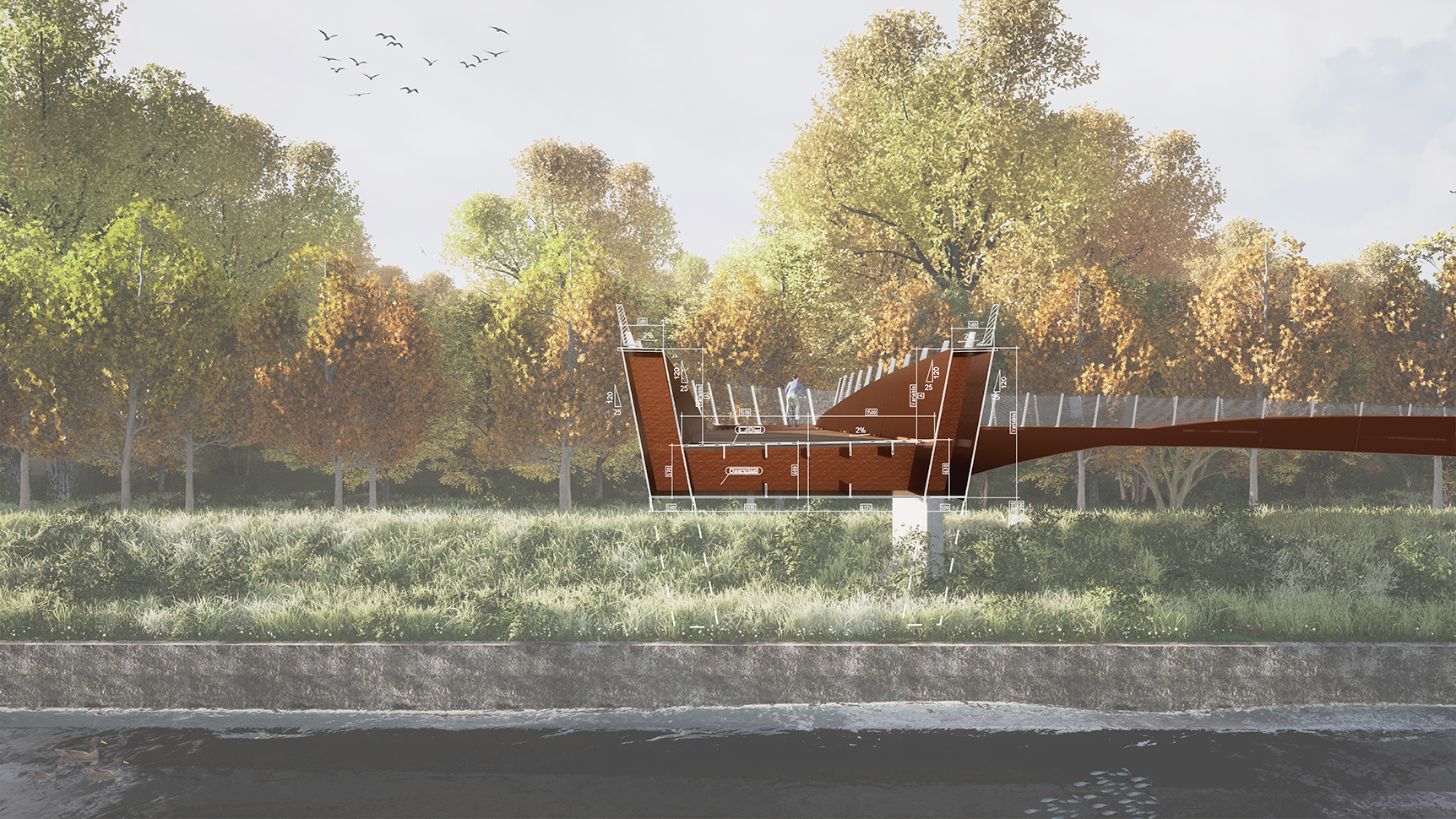
| Categoría | Proyectos de infraestructura |
|---|---|
| Año | 2021 |
| País | Benelux |
| Organización | SBE |
| Autor | SBE |
| Cliente | De Vlaamse Waterweg |
| Lugar de construcción | Wielsbeke-Waregem |
| Tags |
Juryrapport
De nieuwe fiets- en voetgangersbrug Wielsbeke-Waregem van SBE is door de jury gekozen als beste infrastructurele project. Hierbij merkten ze het parametrisch ontwerp, het uitgebreide software gebruik en de overgang tussen het gebruikte staal (de brug zelf) en beton (de aanrijhellingen) op. De gehele brug is getekend en berekend door verschillende ingenieurs en BIM-designers en parametrisch ontworpen met behulp van de softwareprogramma’s Rhino 6 & Grasshopper. Dit model is gekoppeld aan het rekenmodel van SOFiSTiK maar ook aan Tekla Structures en Civil 3D.
Kadering van het project
De nieuwe fiets -en voetgangersbrug Wielsbeke-Waregem kadert binnen het ruimere Seine-Scheldeproject. Dit project beoogt de realisatie van een binnenvaartverbinding op groot gabarit tussen het Seinebekken enerzijds en het Scheldebekken anderzijds. De brug dient een toeristisch-recreatieve verbinding te vormen over de Leie. Hiervoor is als optimale locatie gekozen voor een verbinding tussen Wielsbeke – op de linkeroever, en Waregem- op de rechteroever. Meer concreet bevindt de locatie voor de nieuw te bouwen brug zich ter hoogte van het afwaartse uiteinde van de Leiemeander op Linkeroever. De fiets -en voetgangersbrug zal verder ook een belangrijke schakel zijn in het fietsennetwerk. Op de jaagpaden, langs beide oevers, loopt de fietssnelweg F371. Deze verbindt Komen met Deinze langsheen het traject van de Leie.
BESCHRIJVING VAN HET ONTWERP
Uitgangspunten
Het hoofduitgangspunt voor de fiets -en voetgangersbrug is dat er in het ontwerp wordt gestreefd naar een sobere, harmonieuze brug die zich op deze locatie niet opdringt maar net één geheel vormt met de bestaande bomenrijen en het open karaktervolle Leielandschap. De brug moet, als het ware, verdwijnen in het landschap waarbij het uitzicht niet door uitstekende, visueel dominerende draagelementen belemmerd wordt. De relatie tussen beide oevers dient versterkt te worden door de gebogen en slanke brugstructuur die visueel een rustig en natuurlijk beeld uitstraalt.
Vormgeving
Tijdens de voorstudie van de inplanting en het optimale tracé van de brug is er rekening gehouden met verschillende voorwaarden die bepalend waren voor de vormgeving. Eén van deze voorwaarden is de naadloze overgang van de bestaande omgeving naar de specifiek hoogtepeilen waarop de nieuwe brug moet aansluiten. Hoe meer we het te overbruggen hoogteverschil kunnen beperken, hoe beperkter de aanloophellingen van de brug waardoor het comfort voor fietsers en voetgangers aanzienlijk verbetert. Na de studie is er tot de conclusie gekomen dat een S-vormig tracé het best hierop aansluit.
Materialisatie
De fiets -en voetgangersbrug wordt uitgevoerd in staal. Dit materiaal is robuust en duurzaam maar moet tegen corrosie beschermd worden. Als verwijzing naar de klassieke staalbouw én om de brug een tijdloze uitstraling te geven, heeft de brug als kleur een tint van rode menie gekregen. Het brugdek zelf wordt voorzien met een dunne laag antislip polyurethaan hars. De aanrijhellingen worden uitgevoerd in beton.
(Stabiliteit-)structuur
Doordat de brug geen dominant beeld mag vormen in het Leielandschap is de draagstructuur geïntegreerd in het brugdek. De transparantie met de oever wordt gewaarborgd en net om die reden worden er ook geen pijlers net naast de kadewanden geplaatst. Dit geeft ook een technisch voordeel, namelijk dat de potentiële conflicten tussen de brugfunderingen en de structuur van de kadewanden kunnen vermeden worden. De gehele constructie is opgebouwd uit een gesloten draagstructuur onder andere om eventuele bevuiling door vogels te vermijden.
Samenwerking tussen verschillende afdelingen
De gehele fiets -en voetgangersbrug is getekend en berekend door verschillende ingenieurs en BIM-designers. De brug is parametrisch ontworpen met behulp van de softwareprogramma’s Rhino 6 & Grasshopper. Dit model is gekoppeld aan het rekenmodel van SOFiSTiK maar ook aan Tekla en Civil 3D.
De bestaande toestand, het tracé van de brug én het 3D alignement is getekend in Civil 3D. Deze data is gebruikt in Rhino 6 en Grasshopper om hierrond de andere geometrie op te bouwen. Deze geometrie en data is hierna gebruikt in het rekenmodel in SOFiSTiK, maar ook in Tekla om de stalen brug, de volledige wapening, paalfundering en bekisting te genereren. Door te werken met 1 centraal model kunnen er heel snel aanpassingen gebeuren in het ontwerp.
Door dit project volledig in 3D uit te werken en het gebruiken van de geschikte data, is het van bij de aanbestedingsfase heel eenvoudig om hoeveelheden aan materiaal op te vragen. Het stelt ons ook in staat om deze modellen te gebruiken als bron voor onze visualisaties en deze zijn tevens de basis voor ons complete BIM-model. Tijdens het hele ontwerp stond werken volgens de BIM-methodiek centraal. Hergebruik van modellen en data, centrale bron van informatie & communicatie, dit zijn de essentiële zaken die dit project gesteund hebben.
Jury report
The new bicycle and pedestrian bridge Wielsbeke-Waregem from SBE was chosen by the jury as the best infrastructural project. They noted the parametric design, extensive software use and the transition between the used steel (the bridge itself) and concrete (the approach ramps). The entire bridge was drawn and calculated by various engineers and BIM designers and designed parametrically using the software programs Rhino 6 & Grasshopper. This model is linked to the SOFiSTiK calculation model, but also to Tekla Structures and Civil 3D.
Framework of the project
The new bicycle and pedestrian bridge Wielsbeke Waregem is part of the broader Seine-Scheldt Project. This project aims at the realization of a large gabarit barge connection between the Seine basin on the one hand and the Scheldt basin on the other. The bridge needs to be a tourist and recreational connection over the Leie. As the preferred location for this bridge, there has been chosen for a connection between Wielsbeke – on the left bank, and Waregem – on the right bank. More specifically, the new bridge will be built at the downstream end of the Leiemeander on the Left Bank. The bicycle and pedestrian bridge will also be an important link in the bicycle network. The cycle highway F371 runs along the towpaths along both banks. This connects Komen with Deinze along the Leie.
DESCRIPTION OF THE DESIGN
Starting point
The main starting point for the bicycle and pedestrian bridge is that the design strives for a sober, harmonious bridge that does not impose itself at this location, but just becomes one with the existing rows of trees and the open characteristic of the Leie landscape. The bridge must, as it were, disappear into the landscape, without obstructing the view by protruding, visually dominant supporting elements. The relationship between the two banks should be strengthened by the curved and slender bridge structure that visually radiates a calm and natural image.
Appearance
During the preliminary study of the location and the optimal route of the bridge, various conditions were taken into account that were decisive for the design. One of these conditions is the seamless transition that is needed between the existing environment and the specific height levels to which the new bridge must connect. The more we can limit the height difference to be bridged, the more limited the approach slopes of the bridge, which significantly improves the comfort for cyclists and pedestrians. After the study, it was concluded that an S-shaped route is best suited to this.
Materialization
The bicycle and pedestrian bridge is made of steel. This material is robust and durable but must be protected against corrosion. As a reference to the classic steel construction and to give the bridge a timeless appearance, the color of the bridge has been given a hue of red lead. The bridge deck itself is provided with a thin layer of non-slip polyurethane resin. The ramps are made of concrete.
(Stability-)structure
Because the bridge may not form a dominant image in the Leie landscape, the supporting structure is integrated into the bridge deck. Transparency with the bank is guaranteed and that is precisely why no pillars are placed right next to the quay walls. This also provides a technical advantage, namely that the potential conflicts between the bridge foundations and the structure of the quay walls can be avoided. The entire construction is made up of a closed support structure, among other things to avoid possible contamination by birds.
Colaboration between departments
The entire bicycle and pedestrian bridge has been drawn and calculated by various engineers and BIM designers. The bridge is parametrically designed using the software programs Rhino 6 & Grasshopper. This model is linked to the SOFiSTiK calculation model, but also to Tekla and Civil 3D.
The existing environment and the 3D alignment has been drawn in Civil 3D. This data was used in Rhino 6 and Grasshopper to build the other geometry around it. This geometry and data was then used in the calculation model in SOFiSTiK, but also in Tekla to generate the steel bridge, the complete reinforcement, pile foundation and formwork. By working with 1 central model, adjustments can be made to the design very quickly.
By working out this project completely in 3D and using the appropriate data, it is very easy to request quantities of material from the tendering phase. It also allows us to use these models as a source for our visualizations and they are also the basis for our complete BIM model. Working according to the BIM method was central throughout the design. Reuse of models and data, central source of information & communication, these are the essential things that have supported this project.
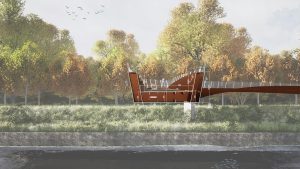


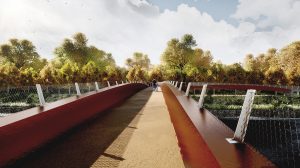


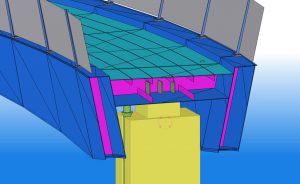



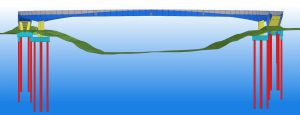
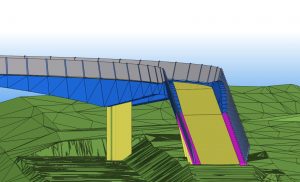

Prachtig